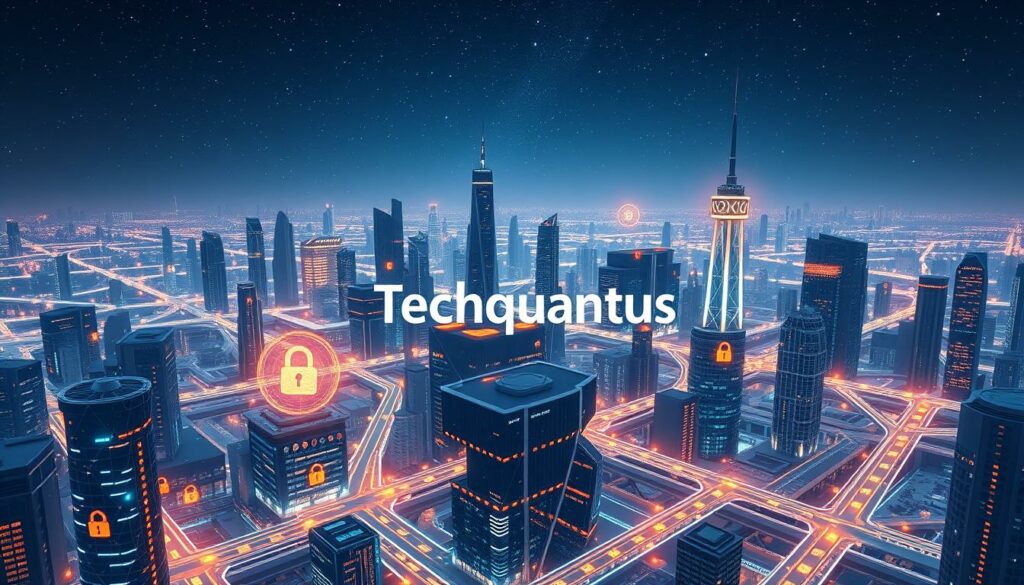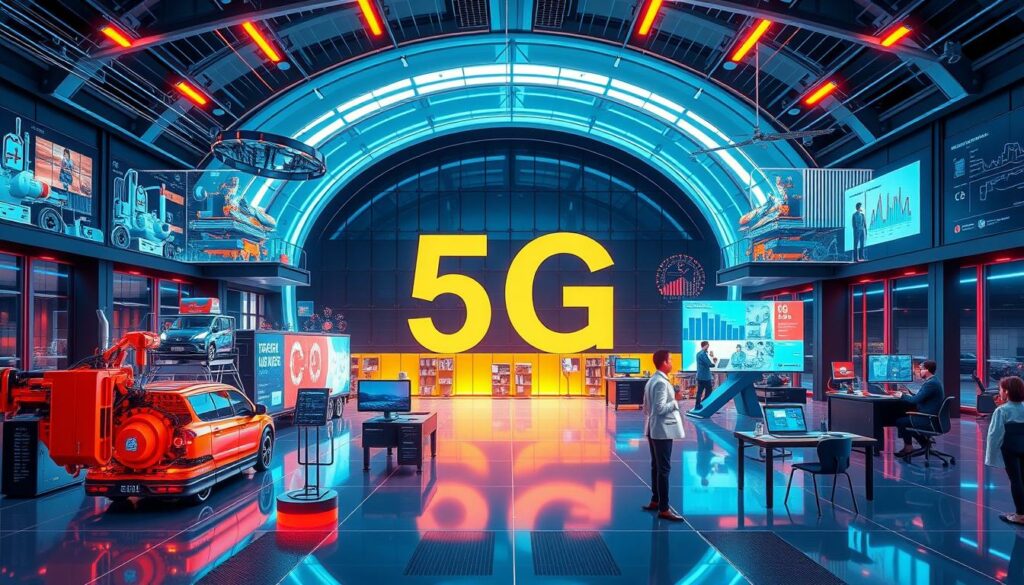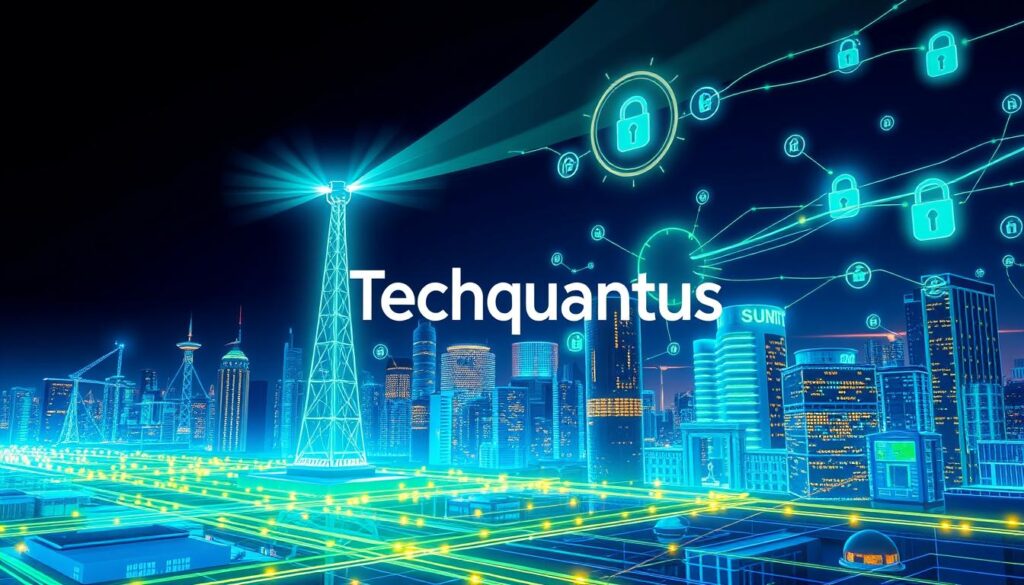The biggest IT outage in history was caused by a single faulty software update. It affected 8.5 million systems and caused big problems in industries like air travel and healthcare. This shows how important technology, infrastructure, and security are today. As companies move to 5G, the risks are higher.
Business spending on AI is expected to jump from $235 billion in 2023 to $631 billion by 2028. This makes it crucial to understand how 5G affects IT infrastructure and security.
5G technology brings faster data transfer speeds and better connectivity. This opens up new chances for businesses to innovate and improve. But, these new features also bring new challenges and risks for IT professionals.
We will look at how 5G can change your IT infrastructure. We will also talk about the security issues that need to be solved to protect your business.
Key Takeaways
- 5G technology can significantly enhance your IT infrastructure’s capabilities.
- Increased speed and efficiency may introduce new vulnerabilities in IT Security.
- The rise of AI spending highlights the urgent need for robust security measures aligned with 5G implementation.
- Understanding these changes is vital for organizations aiming to leverage technology effectively.
- New complexities in 5G environments require proactive cybersecurity strategies.
Introduction to 5G Technology
5G technology is a big step up from 4G, offering speeds up to 100 times faster. This means better connectivity and more network advancements.
It uses small antennas placed close together for strong signals everywhere. This helps connect many devices, changing how we use technology in healthcare, transport, and farming.
5G networks run on high-frequency waves, like millimeter waves. These waves might cause environmental issues. But, the need for fast and reliable connections is growing. So, 6G is coming, aiming for speeds 100 times faster than 5G and using AI to manage networks better.
Big companies are testing 5G Broadcast, showing we need better communication tech. European broadcasters are already working on it. As network advancements grow, how we talk to each other could change a lot, shaping our future.
Understanding IT Infrastructure
IT infrastructure is made up of hardware, software, networks, and data centers. It supports the work of IT services in an organization. A strong IT infrastructure is key for managing data, applications, and security well. This ensures the business keeps running smoothly and efficiently.
Key components of IT infrastructure include:
- Servers: These are powerful computers that store and manage network resources.
- Data storage solutions: These allow for the secure storage and access of vital information.
- Networking equipment: Routers, switches, and firewalls that facilitate seamless communication within and outside the organization.
- Cloud computing services: These enable organizations to expand their capabilities without significant upfront investment in physical hardware.
- Virtualization technologies: They enhance resource utilization and simplify management and provisioning of IT resources.
As businesses move forward, the importance of IT infrastructure grows. New network technologies change how organizations work. This is especially true when adopting 5G technology. Having a strong IT infrastructure is key to staying ahead in the competition.
5G technology has a big impact on IT infrastructure. It brings faster data transfer rates, better connectivity, and advanced cloud services. By embracing these changes, businesses can find new ways to grow and innovate.
How 5G Enhances IT Infrastructure
5G technology is a big step up for IT infrastructure. It brings many improvements that change how businesses handle their IT systems. These changes make things more efficient and open up new chances to use speed and connectivity.
Increased Data Speeds and Bandwidth
5G enhancements bring a huge jump in data speeds and bandwidth. This means big amounts of data can move fast, making work flow better. Businesses will see:
- Faster downloads and uploads of data.
- Bottleneck reduction during peak usage times.
- Enhanced performance for data-intensive applications.
Improved Connectivity and Network Reliability
5G also makes connections and networks more reliable. Businesses get steady connections that don’t often go down, making people more productive. Key features include:
- Robust connection consistency.
- Lower latency that supports real-time applications.
- Greater support for a higher number of connected devices.
Impact on Cloud Services and Data Centers
The benefits of IT infrastructure benefits from 5G are big for cloud services and data centers. Better connections make data centers work better, handling more work. Look at the effects:
- Increased ease of data synchronization across cloud platforms.
- Greater scalability for cloud services to grow with user demand.
- More efficient resource allocation, optimizing operational costs.
| Enhancements | Benefits |
|---|---|
| Increased Data Speeds | Rapid data transfer allowing faster operations |
| Improved Connectivity | Stable connections reduce downtime and increase efficiency |
| Enhanced Cloud Services | Higher capacity for data management and effective resource allocation |
Adding 5G technology to your IT setup can open up new possibilities. It leads to faster work, better reliability, and big cost savings. Companies that adopt these changes will get a big edge in their fields.
5G and IT Security: New Challenges Ahead
5G technology has changed the way we communicate online. It offers fast data transfer and better connectivity. But, it also brings 5G security challenges that need attention. Protecting data is harder with more connections.
Threats to Data Privacy
Businesses using 5G face big data privacy risks. The network’s speed and data volume increase the risk of exposing sensitive info. Hackers can use new methods to get into personal and company data.
Increased Attack Surface
5G networks give cybercriminals more ways to attack. With more connections, there are more ways for threats to get in. Companies must update their security to keep up. They need to use new tech to fight off these threats.
The Role of Fiber Optics in 5G Networks
Fiber optics are key to 5G networks, boosting data transmission. They handle more data at faster speeds, making 5G technology work better. As we connect more devices, the need for efficient fiber optics will grow.
Benefits of Fiber Optics in Data Transmission
Fiber optics bring big benefits to 5G networks:
- High Capacity: They can send lots of data at once, which is key for 5G’s needs.
- Speed: Fiber’s fast data transfer cuts down on wait times, making communication quicker.
- Durability: Fiber stands up better to the elements, offering reliability in tough conditions.
- Cost-Effectiveness: Though starting costs are high, saving on maintenance and efficiency makes fiber a wise choice.
Market Growth Potential for Fiber Optics
The fiber optics market is growing fast, thanks to 5G’s rise. Here are some key stats:
| Year | Market Value (in Billion USD) | Notes |
|---|---|---|
| 2024 | 3.2 | Starting point for growth as 5G commercialization expands. |
| 2029 | 6.8 | Projected total market value showing a significant increase. |
| 2024-2029 CAGR | – | 16.4% |
Asia Pacific is leading in this market, with a strong growth forecast. Companies like Corning Incorporated and Sumitomo Electric Industries are innovating for 5G’s demands.
Security Measures for 5G Infrastructure
The 5G technology brings new chances and challenges for keeping IT safe. It’s key to use strong security steps to guard against threats. Encryption and new methods like network slicing help make 5G safer.
Encryption and Authentication Protocols
Strong encryption protocols are a must to fight off security risks. They keep data safe as it moves between devices and networks. Encryption adds a secure layer, making it tough for hackers to get to sensitive info.
Authentication protocols are also crucial. They check if devices are really who they say they are. This makes sure only approved users and devices can get into the network.
Network Slicing for Improved Security
Network slicing is a new way to make many secure networks in one physical one. It lets you share the same network for different needs. This means you can set up special 5G security for each use, like for very secure apps.
This way, apps needing extra security get their own slice. It lowers the risk of attacks and keeps data safe.

| Security Feature | Description | Benefits |
|---|---|---|
| Encryption Protocols | Methods to secure data transmission | Maintains data confidentiality and integrity |
| Authentication Protocols | Verification methods for device identity | Prevents unauthorized access |
| Network Slicing | Creation of isolated networks within the main infrastructure | Customizes security measures per application |
Government Regulations and Compliance
The fast growth of 5G technology brings new government rules that companies must follow. As 5G changes many areas, making sure IT systems follow the rules is key. Companies must keep up with changes to protect data and keep systems safe.
Compliance Challenges for Organizations
Companies using 5G face many compliance issues. They need to understand complex 5G rules, like GDPR in Europe or CCPA in California. Being compliant means handling data right and making sure IT systems meet strict rules. Here are the main compliance challenges:
- Data Privacy: Protecting personal data gets harder as 5G networks grow and more data is made.
- Security Standards: Companies must follow stricter security rules, which changes their IT plans.
- Regulatory Diversity: Different places have different rules, making it hard for companies that work across borders.
- Cost of Compliance: Following the rules can be expensive, needing big investments in people and technology.
| Regulation | Region | Focus Area |
|---|---|---|
| GDPR | Europe | Data Privacy |
| CCPA | California | Consumer Rights |
| FCC Regulations | United States | Telecommunication Standards |
| PIPEDA | Canada | Data Protection |
It’s crucial for companies to keep up with these rules in a 5G world. Having a plan that covers 5G rules and IT compliance helps avoid risks and use new tech well.
Future of IT Infrastructure with 5G
The arrival of 5G technology is changing the IT world. It’s much faster than 4G, up to 100 times. This means businesses can work better and innovate more. They will use 5G to make things run smoother, focusing on improving customer experiences and creating new apps.
5G uses millimeter waves to carry lots of data fast. This is great for healthcare, transport, and farming. When combined with AI, machine learning, and IoT, it opens up new possibilities.
But, moving to 5G isn’t easy. It’s expensive and takes a lot of time to set up. Also, 6G is coming, which will be even faster. This will add more complexity to our IT systems.
5G is already showing its power in projects like 5G campus networks. For example, a project got 1 million euros to cover 30,000 square meters. It uses frequencies from 3.7 to 3.8 gigahertz. This shows how important 5G is for businesses and people, making online activities safer and faster.
Looking ahead, we’ll see more research in areas like self-driving cars, logistics, and healthcare. These innovations will change IT infrastructure to meet today’s needs. As companies use 5G fully, IT infrastructure will change a lot, affecting industries worldwide.
| Feature | 4G | 5G | 6G (Predicted) |
|---|---|---|---|
| Speed | Up to 1 Gbps | Up to 100 Gbps | Up to 1 Tbps |
| Frequency | Below 6 GHz | 3.7 – 3.8 GHz | Above 100 GHz |
| Industry Impact | Moderate | Significant | Transformative |
| Key Applications | Mobile internet, video streaming | IoT, AR, healthcare | Autonomous systems, enhanced connectivity |
Real-World Applications of 5G in Business
5G technology is changing the game in many sectors with its new business uses. It’s making it easier for companies to work in new ways, changing how they do business. For example, in healthcare, 5G lets doctors check on patients in real-time and offer remote care.
In manufacturing, 5G helps with automated machines and IoT devices. This means better production and safety with less downtime. Smart factories using 5G work more smoothly and have fewer stoppages.
The logistics industry gets a boost from 5G with better supply chain management. Tracking and analyzing in real-time helps plan routes and manage stock better. This leads to lower costs and happier customers for businesses that use 5G.
For agriculture, 5G means better management of resources and monitoring crops. Farmers use data to make smart choices, which can lead to more food and sustainable farming.
| Industry | Application | Benefits |
|---|---|---|
| Healthcare | Remote patient monitoring | Enhanced patient care, timely interventions |
| Manufacturing | Automated machinery | Increased efficiency, reduced downtime |
| Logistics | Real-time tracking | Optimized routes, improved inventory management |
| Agriculture | Data-driven farming | Increased yield, sustainable practices |

Impact of 5G on Internet of Things (IoT)
The arrival of 5G is changing the Internet of Things (IoT) in big ways. It lets more connected devices work together without slowing down, especially in smart cities. This means faster data transfer and automation in many areas.
The smart cities market was worth USD 621.4 billion in 2022 and is expected to grow to USD 5,759.3 billion by 2032. North America is leading the way, but Europe and the Asia-Pacific are catching up fast. They’re expected to see the biggest growth rates.
5G is key for many new technologies:
- Industrial IoT (IIoT) makes industries like manufacturing and energy more efficient.
- Smart hospitals use IoT devices like smart beds to care for patients better.
- Wearable devices send health data in real-time, helping catch problems early.
- Telemedicine gets better with IoT, making remote health checks easier.
As companies use these technologies, the global IoT market is set to hit $1 trillion by 2026. This shows IoT is a top priority for businesses. Big names like IBM, Cisco Systems, Siemens AG, Schneider Electric, and Microsoft are leading the charge with 5G.
| Market Insights | 2022 Value | 2032 Value | CAGR (2023-2032) |
|---|---|---|---|
| Smart Cities Market | USD 621.4 billion | USD 5,759.3 billion | 25.2% |
| IoT Global Spending | Not applicable | USD 1 trillion | Not applicable |
These numbers show how big the 5G IoT impact is on industries that rely on connected devices. It’s driving innovation and boosting efficiency across the board.
Case Studies: Companies Adapting to 5G
Many businesses are diving into 5G technology, showing how they’re changing their ways. The car and manufacturing industries are big on using 5G for quick analytics and automated tasks. This has made them more productive and efficient. These stories show how 5G is changing the game, helping companies update their whole process.
Companies like ViewSonic are at the forefront of this change. They’re showing off new tech at events like InfoComm India 2024 in Mumbai. They’re using 5G to make communication and teamwork smoother. With new products like a huge interactive display, they’re embracing smarter digital solutions.
In the SaaS world, platforms like Qoruz are keeping up with fast-paced influencer marketing. They focus on precise data and easy-to-use tools, thanks to 5G. This means better campaign management and a deeper look into how well their messages are reaching people.
The following table outlines specific 5G case studies and their impacts on business transformation:
| Company | Industry | 5G Application | Impact on Operations |
|---|---|---|---|
| ViewSonic | Visual Technology | Interactive Displays | Enhanced collaboration and engagement at trade shows |
| Qoruz | SaaS/Marketing | Influencer Marketing Tools | Increased efficiency in campaign management and insights |
| Automotive Manufacturers | Automotive | Real-Time Analytics | Boosted productivity and streamlined processes |
| Manufacturers | Manufacturing | Automated Procedures | Greater operational efficiency and precision |
These examples show how big a leap companies can make with 5G technology. They highlight strategies that are changing how businesses work.
Conclusion
The 5G impact summary is huge, changing how companies work and use technology. It brings big benefits like better efficiency and connectivity. But, it also brings big challenges, especially in IT security.
New cybersecurity threats are a big worry. It’s key to plan carefully to keep your systems safe. This means being very careful with 5G technology.
It’s important to focus on data privacy and security risks it brings. Having strong security steps, following the rules, and teaching people about these issues is crucial. This way, you can use 5G’s benefits safely.
Staying ahead in security and following the rules is key. The future is about using 5G’s good points and fixing new security issues. This balance helps you run better and innovate, keeping you ahead in the digital world.
For more info, check out what leaders in the field say. Look at the ALTEO Group for insights.
FAQ
What are the main benefits of 5G technology for IT infrastructure?
5G technology boosts IT infrastructure by offering much faster data speeds and more bandwidth. This means data transfers quicker. It leads to better connectivity, more reliable networks, and less downtime. This, in turn, increases productivity and efficiency for businesses.
How does 5G impact data security?
5G has many benefits but also brings new security challenges, especially with data privacy. The more connected devices create a bigger target for hackers. Companies need to update their security plans to handle these new risks.
What role do fiber optics play in 5G networks?
Fiber optics are key for 5G networks because they help send data fast and support high-bandwidth needs. As 5G grows, so will the need for fiber optics.
What security measures should organizations consider for 5G?
To keep 5G safe, companies should use strong encryption and check identities to secure messages. Network slicing can also help by separating resources for different uses. This makes it easier to keep data safe by keeping it separate.
What compliance regulations do organizations need to follow when adopting 5G?
Companies using 5G must follow many rules to keep data private and secure. This includes the GDPR in Europe and the CCPA in California. These laws affect how companies set up their IT and security plans.
How will the future of IT infrastructure evolve with 5G technology?
5G will change the future of IT a lot. Companies will use it to make operations more efficient and bring new business ideas. Technologies like AI, machine learning, and IoT will also change IT in big ways with 5G.
Can you provide examples of industries using 5G technology?
Industries like healthcare, manufacturing, and logistics are using 5G for big changes. For example, 5G helps with real-time data analysis to improve supply chains and remote health services. This helps businesses work better and change their models.
What is the significance of 5G for the Internet of Things (IoT)?
5G makes the Internet of Things (IoT) better by letting more devices connect without slowing down. This is key for smart cities, where lots of devices need to work together well and stay secure.
Source Links
- 3 No-Brainer Artificial Intelligence (AI) Stocks to Buy With $200 Right Now | The Motley Fool
- CrowdStrike to testify before US Congress committee
- The Future of Networking: 5G and Beyond
- 5G Broadcast handset taskforce publishes receiver profile
- 5G in Smart Factories: Revolutionizing Manufacturing
- ViewSonic India will Showcase Futuristic Large-size Displays at InfoComm India 2024
- How Data is Shaping the Future of Influencer Marketing: Insights from Mothi Venkatesh, Head of Growth at Qoruz
- Heparin (Low Molecular Weight) Market Overview: Growth, Size, and Forecast Insights
- Fiber Optics Market worth $6.8 billion by 2029 – Exclusive Report by MarketsandMarkets™
- Single Board Computer Market Set to Worth Over USD 7,486.1 Million By 2032 | Astute Analytica
- Why one of France’s biggest IT companies is cutting its revenue forecast – Times of India
- Musk’s Brazilian bust up sees Starlink accounts frozen
- Telecom and Networking: Optimize Your Network with Movate!
- Future of iGaming: Innovations Shaping the Industry
- How can houses be demolished without following procedure prescribed by law, asks SC
- Merseburg University, Deutsche Telekom Introduce Private 5G Campus
- 13 forecasts for a 2040 South Africa anchored by energy security
- European market players join forces for 5G Broadcast smartphones
- Smart Cities Market Projected to Reach USD 5,759.3 Billion by 2032 As Revealed In New Report
- The IoT Trends Shaping Industry in 2024 and Beyond
- Digital Inclusion for Grassroots & Underprivileged Communities.pdf
- Xiaomi Offers 20% Discount on Battery Replacement for 32 Models
- ESPN networks, ABC and Disney channels go dark on DirecTV on a busy night for sports
- Quantum Computing Basics for Beginners: A Simplified Guide
- I Use Prompt Engineering Templates That Work Across ChatGPT, Gemini, Claude & Grok
- I Use Small Business AI Stack: Affordable Tools to Automate Support, Sales, Marketing
- Remote Work Productivity Tips: Maximize Efficiency
- The AI Snitch: Why Grassing Out Colleagues, Even for “Efficiency,” Backfires




